Filipino Diet Meal Plan for Weight Loss (Free 30-Day Meal Plan)
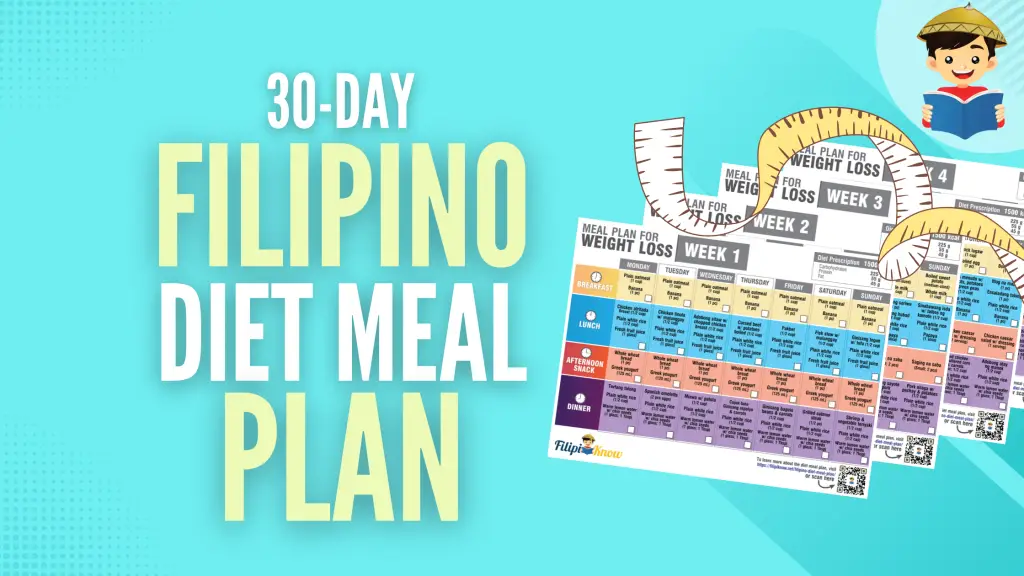
When your blood sugar drops and you get hungry, you tend to eat everything you can get your hands on. Many of us choose the nearest fast-food restaurant with unhealthy options. Meal planning solves this problem because it enables you to have a balanced meal at your disposal, loaded with nutrient-dense food that is prepped and ready to go.
Now the question is, how should you do it?
If you want to lose weight without starving yourself to death, you can try our free 30-day Filipino diet meal plan with mostly familiar local recipes you can easily prepare at home.
Related: How To Start a No Rice Diet to Lose Weight (Free Diet Meal Plan)
Table of Contents
What Is a Meal Plan?
Meal planning is the process of planning and writing down any of your meals a week or month in advance for yourself or your family. It is a simple way to help you achieve your fitness goals, whether attempting to lose weight or improving your nutrition by giving your body the nutrients it requires to function and remain healthy.
Benefits of Meal Planning
Various benefits to preparing your meals beforehand may help you lose weight while improving your health. These include the following:
1. Learning Portion Control
You can observe how much you are consuming if you plan your meals. This also keeps you from overeating at restaurants, which provide far more food than your body needs.
2. Eating Healthy Meals
Unhealthy meals are frequently selected for their convenience. Fruits, veggies, whole grains, and legumes will become more convenient and consumed more often if we take the time to plan meals, prepare a grocery list, and have them on hand.
3. Saving Time
It’s hard enough to be hungry, but getting hungry and realizing there are no meals prepared beforehand is doubly hard. With meal planning, you may have a nutritious dinner ready in minutes, so you won’t stand in front of your fridge or cupboard contemplating what to make.
4. Saving Money
Conserving money is a goal we all strive for, and meal planning is a fantastic way to start. In addition to avoiding dining out, meal planning entails purchasing goods in bulk, saving you a lot of money. Sticking to the grocery list also helps you prevent impulsive purchases.
5. Avoiding Food Waste
When it comes to meal planning, you go to the grocery store with a strategy for using each item. This way, you will not have to worry about food going bad because you know exactly what each food will be used for. Taking the time to prepare your meals ahead of time is well worth the effort, whether you are cooking for your whole family or just yourself. The trick is to devote a small amount of time each week.
However, it has a few disadvantages worth noting. With meal planning:
- You may not feel like cooking after work
- The dishes you thought would be delicious might be a disaster
- You are required to be organized and disciplined, attributes which you may lack
- You will need to make a timetable and follow it as closely as feasible, which again requires discipline
Many people have different ideas about meal planning. Some people make a grocery list based on the meals they expect to cook and consume over the week. Others prepare and divide their meals using meal prep containers, allowing for less weekly cooking. Others get a combination of the two! Just a reminder that the most critical aspect of good meal planning is making sure you prepare everything you planned on preparing each week. But how should you plan your meals?
How To Prepare Filipino Diet Meal Plan
When planning your meals for weight loss, ensure that the three macronutrients– carbohydrates, protein, and fats–-are all present. Carbohydrate-rich foods should provide 55% of the calories, while fats and proteins should provide 30% and 15%, respectively.
Also, drink plenty of water, ideally at least eight glasses daily. Otherwise, you run the danger of being dehydrated.
Below are some tips if you have no idea where to start!
- Choose a meal time that you find challenging to prepare. If you constantly struggle with what to eat during dinner, you might want to focus on this meal first and plan to save time and money.
- Plan out what you will eat for the said meal for the following three days. If you are looking for a place to start, check your cupboard for some ingredients you already have.
- Put your scheduled meals on paper, on a calendar, in an app, or print off one of “my meal planner” templates and hang it on the fridge.
- Make a grocery list based on your planned recipes. Stick to your shopping list as much as possible. Meal preparation can help you save money in this way.
- Make the meals you have planned a reality by actually preparing them. You do not have to accomplish everything precisely as you planned, but at least attempt it for three days until you can finally follow it for a week, eventually up to a month! Make excellent home-cooked meals to use up your ingredients.
Free Sample 30-Day Filipino Diet Meal Plan for Weight Loss
Are you finding it hard to make your meal plan? Here’s a sample 30-day Filipino diet meal plan you can follow, download, and print for free!
Disclaimer: The sample meal plan below is for educational and informational purposes only and is not intended to substitute medical advice. Dietary needs vary based on age, sex, height, weight, physical activities, and any chronic health illnesses. Before starting any diet, speak with your physician and/or nutritionist-dietitian.
Download our free 30-day Filipino diet meal plan in printable PDF
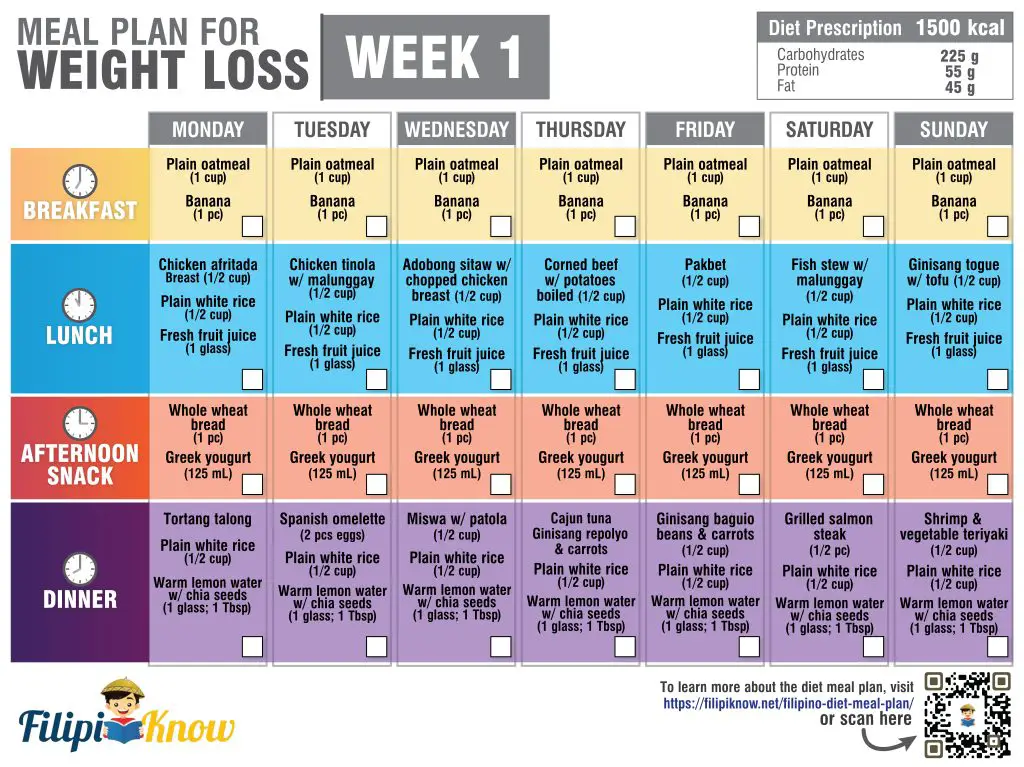
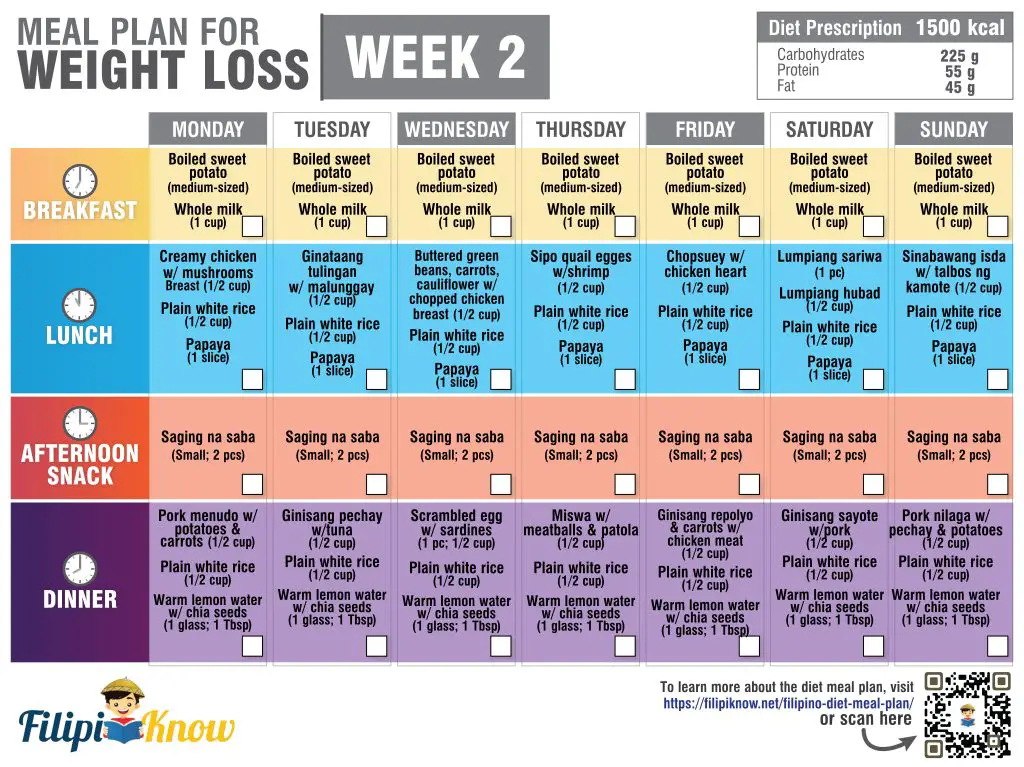
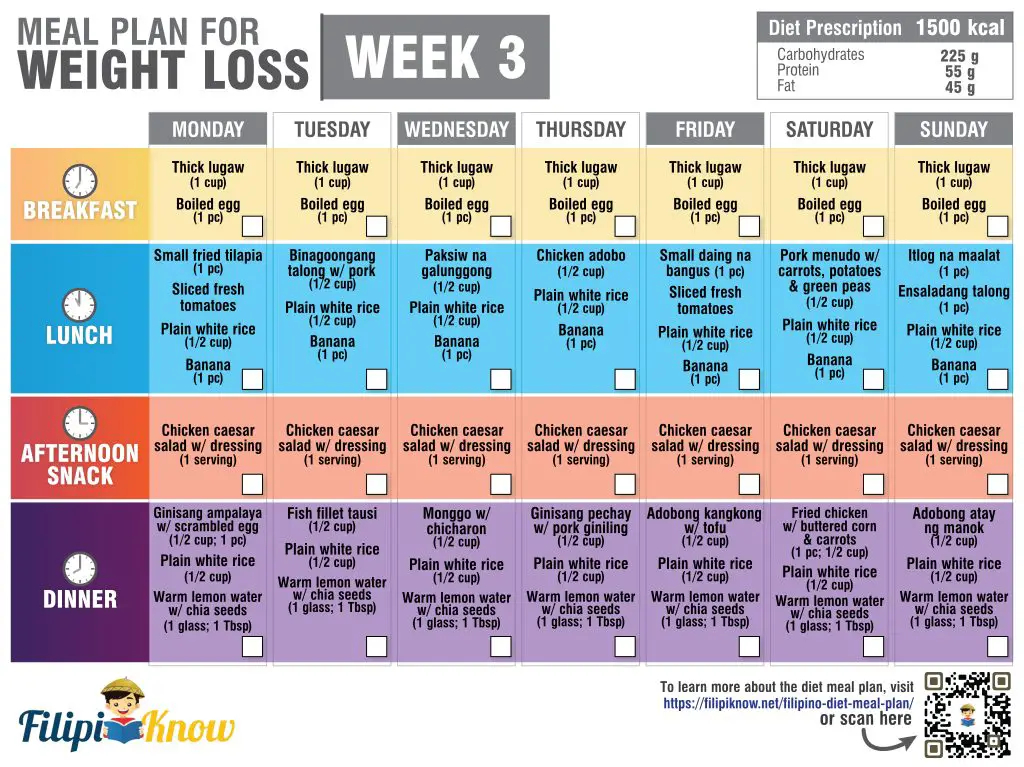
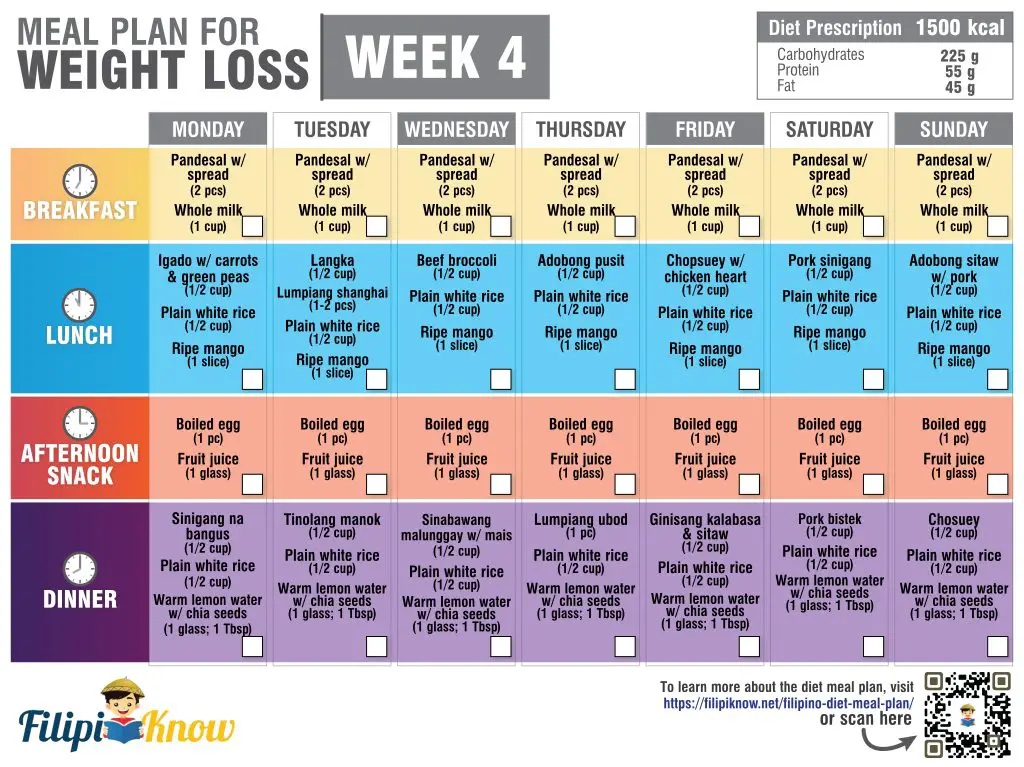
Download our free 30-day Filipino diet meal plan in printable PDF format
General Guidelines
- Servings of meat (fish, chicken, pork, and beef): 2-3 matchbox sizes only
- Servings of salads: 1-2 cups (128g/cup)
- Servings of rice/pasta/root crops: 1 cup (120g)
- Servings of any bread: 1-2 pcs.
- Servings of spread: 1 tbsp only (5g)
- All meat should be lean as they are generally low in fat. Lean meats are chicken breast, pork tenderloin, beef sirloin, tilapia, mackerel, and salmon.
- Drink a lot of water (at least eight glasses a day); drink a glass before and after a major meal.
- Take a moment to think about whether you are hungry/just craving/bored.
- Avoid processed foods (i.e., canned or packaged foods; chips; and fast food), fried foods, and foods that are too sweet or salty.
- Use olive or canola oil at home and avoid reusing the same oil for frying as it increases the number of free radicals in the body, leading to inflammation, which is the underlying cause of most diseases, such as obesity, heart disease, and diabetes.
- Eat major meals at the same time every day.
- Social events are a dieting minefield; attend them with caution, and go prepared.
- Familiarize yourself with calorie counting; always check calorie contents on food labels.
- Light-intensity physical activities (at least 30 mins/day) are recommended. Exercise, but do not overexert yourself if you are running on just 1,500 calories a day.
Our free 30-day weight loss meal plan can help you lose weight while eating healthy foods. This is a 1,500-calorie diet plan designed to keep you feeling energized and satisfied while reducing calories so you can lose about 1 to 2 pounds each week. This diet also includes the best Filipino meals for weight loss, featuring high protein and fiber foods that will help you lose weight by keeping you full longer.
Remember that if you are an active and bigger individual with much muscle mass, this calorie-per-day diet may not be enough for you. For example, 1,500-calorie diets are usually designated for individuals with light-intensity physical activities. They are not suitable for some males who have athletic built bodies or active persons of any gender as these groups of individuals may need to consume more daily calories for their body system to function well and get enough nutrients from food.
Before starting any new diet, a consultation with your nutritionist-dietitian is still preferable to know the recommended calories.
Tips and Warnings
1. Losing weight goes beyond a diet meal plan
It is about making a lifestyle change, and the best way to do this is by adopting new habits that become second nature to you over time. So instead of looking for quick fixes, set yourself up for success by incorporating these gradual changes into your life.
2. Food should be fuel for your body, not just something you shove down your throat because it tastes good or makes you feel better temporarily
To fuel your everyday activities and perform at your best mentally and physically, you must consume adequate calories, emphasizing nutrient-dense meals.
You need real nutrients from natural ingredients like lean proteins from chicken breast or tokwa; healthy fats from nuts and seeds; whole grains like white rice or quinoa; leafy greens such as cabbage, talbos ng kamote, or lettuce; fruits such as papaya, watermelon, and mangoes which are loaded with antioxidants; legumes which provide protein while also being low in fat, and the list goes on.
3. Do not be intimidated by the word “meal plan”
Weight loss that is moderate and consistent is simpler to sustain psychologically and physically. Anything can be adjusted according to your food preferences. It is for you, so do not worry if you cannot follow the exact ingredients and amounts.
Remember, meal plans are designed to be a guide, not a set of strict regulations that induce stress. If you do not like eating the same thing daily, planning is even more crucial to save time and money and make good choices. You may cook many chicken or other meat in various dishes throughout the week.
4. Following a meal plan is not the only way to lose weight
You must combine it with regular exercises to create a calorie deficit. As a result, you will benefit from decreased health risks, a healthy metabolism, stronger muscles and bones, a longer life span, and a healthier heart and lungs.
5. Preparing a weight loss diet meal plan has a learning curve
Creating a diet meal plan from scratch might take longer for first-timers. But once you have established a strategy, you will eventually speed through the routine. It will feel good to get organized and achieve your weight loss goals even better. So give yourself enough time to complete the preparation steps and stick to your meal plan.
Frequently Asked Questions
1. I am diagnosed with diabetes and hypertension. Can I use this 30-day meal plan?
A good meal plan for diabetes and hypertension tells you when, what, and how much to eat to provide the nourishment you need while staying within your target blood sugar and cholesterol levels and allowable sodium consumption.
A consultation with your registered nutritionist-dietitian must ensure that your meal plan is individualized and will consider your medical condition, preferences, lifestyle, and medications.
2. Is the 30-day meal plan applicable too for kids?
Children’s meals should not be restricted to a certain number of calories, as suggested in this article’s sample meal plan for weight loss. Thus, these meals may be followed, but the serving sizes should depend on your child’s appetite.
3. Is the 30-day meal plan applicable too for the elderly?
Nutritional requirements differ by age; hence the meal plan in this article may not be the best for those in their 60s. The food and beverages that make up their healthy diet may need to be different as older persons will need to consume less for some nutrients and more for others, in general. A consultation with a registered nutritionist-dietitian is advised for a safe, individualized meal plan.
4. I see some foods in the meal plan that I am allergic or intolerant to. What should I replace them with?
Learning how to substitute ingredients and alternative cooking methods should come in handy. You should be able to make necessary changes in the meal plan according to your medical conditions, such as having food allergies and intolerances. For example, if you are allergic to eggs, you may use tofu instead, as they have almost similar nutritional values.
5. I suffer from an eating disorder, specifically binge-eating disorder. How can meal planning help me?
Controlling food consumption systematically is critical while recovering from Binge Eating Disorder (BED). Structured eating is planning meals with a healthy, balanced diet and a pleasant connection with food. Regarding your dietary demands, a registered nutritionist-dietitian can guide you with your meals and eating habits.
6. Is the meal plan presented here low in carbohydrates or calories? What’s the difference, anyway?
The free meal plan in this article is low in calories for an average, healthy individual with a recommended Total Energy Requirement (TER) that ranges from 2,000 to 2,500 calories daily.
A low-calorie diet is a structured diet that limits daily caloric consumption, usually to lose weight. This entails eating between 1,200 and 1,500 calories per day, resulting in a calorie deficit that can contribute to weight loss. On the other hand, a low-carbohydrate diet prioritizes protein and fat; thus, carbohydrates such as grains, starchy vegetables, and fruits are limited. Its goal is to make the body burn stored fat for energy, resulting in weight loss.
Bermonica Satuito, RND
Bermonica Satuito is a Registered Nutritionist-Dietitian (RND) who earned her degree from the University of the Philippines (UP) Los Baños. She is currently practicing in the medical aesthetics industry after working in research at WHO (World Health Organization) Philippines. Qualified and trained in educating individuals to achieve optimum well-being, she writes and creates content about health on various platforms. Youth leadership, community volunteering, SDGs, ASEAN, and entrepreneurship are among her interests.
Copyright Notice
All materials contained on this site are protected by the Republic of the Philippines copyright law and may not be reproduced, distributed, transmitted, displayed, published, or broadcast without the prior written permission of filipiknow.net or in the case of third party materials, the owner of that content. You may not alter or remove any trademark, copyright, or other notice from copies of the content. Be warned that we have already reported and helped terminate several websites and YouTube channels for blatantly stealing our content. If you wish to use filipiknow.net content for commercial purposes, such as for content syndication, etc., please contact us at legal(at)filipiknow(dot)net
